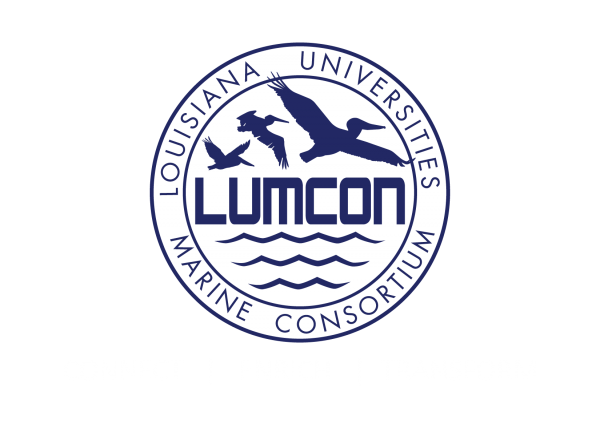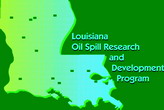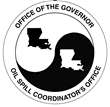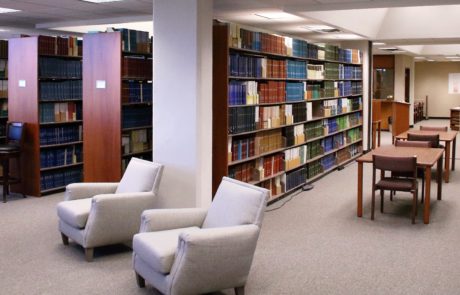LIBRARY
MAIN CATALOG (Electronic Resources/LUMCON Library)
Click here to search the Dispersants Bibliography
Click here to search Effects of Offshore Oil and Gas Development Bibliography
ABOUT THE LIBRARY
The LUMCON Library collection was originally housed in Ellender Memorial Library, located at Nicholls State University in Thibodaux, Louisiana. After completion of the DeFelice Marine Center in 1986, the collection was moved to its present location. Since that time, the Library has become an active resource center for LUMCON faculty and staff as well as Consortium member institutions, visiting researchers, students, and the public.
The library contains a computer lab and several study spaces available to visiting students, scientists, or groups (such as attendees of a writing retreat).
The collection and development of library materials reflects LUMCON’s research programs. The collection has approximately:
- 4,600 monographs
- 5,800 bound volumes
- 200 journal titles
- 26 current journal subscriptions
- 850 maps
- 35 atlases
- 3,600 government documents
- 1,500 reprints
In addition, the library houses a complete collection of research products generated by DeFelice Marine Center personnel since LUMCON’s inception.
HOURS OF OPERATION
- The LUMCON Library is staffed Monday through Friday from 7:00 AM to 3:30 PM. All visitors are welcome during these hours.
- The Library is closed to the public on weekends, state holidays, and when the librarian is not on site. Before visiting the facility, please call 985-851-2875 to ensure the Library will be open.
- All LUMCON staff, summer students, and resident visitors have 24-hour access to the Library. If the doors to the Library are locked, the security guard will open them for you.
CIRCULATION
- Books can be checked out by filling out a card at the circulation desk. The length of time a book can be checked out varies depending on the patron’s status. Books may be renewed by contacting the department, but all items are subject to recall at any time.
- Interlibrary loan service is available for LUMCON faculty, postdocs, lab personnel, and summer students. Although we strive to get items at no charge, the patron may be asked to pay for interlibrary loan charges under certain circumstances.
- Reserve items, reference materials, and journals must remain in the Library. The Library has no photocopier, but copies or scans can be made in the LUMCON main office.
- All materials must be checked out before removal from the Library, without exception.
- Library materials can be placed on reserve for summer classes. A list of items to be placed on reserve should be provided to the librarian as soon as possible.
- When returning material that has been checked out, please drop off items at the circulation counter.
Food is not allowed in the Library under any circumstance. Drinks are only allowed with prior approval by the librarian or the security guard.
INTERNSHIP PROGRAM
The LUMCON Library is available as an internship site for graduate-level students who have completed at least two semesters toward a Master’s degree in Library and Information Science. Applications will be accepted on a continuing basis and internships may be completed during any semester. Prior library experience or an undergraduate degree in science is desirable, but not necessary. Credits will be awarded based on the number of person-hours completed (40 person-hours per credit hour).
The internship will consist of both field experience, encompassing many operations of a special library, and a special project in technical services. The Librarian will give the intern an overview of reference services, technical services, library administration, and budgeting, and will guide the intern through special projects. The LUMCON Library uses SIRSI/Dynix’s Symphony Integrated Library System as well as OCLC for Cataloging/Interlibrary Loan services.
Contact the Librarian for more information or to apply for an internship.
ACKNOWLEDGMENTS
We would like to thank the following individuals for their guidance and input when creating the Dispersants Bibliography:
-
- Victoria Broje, Per Daling, Alun Lewis, and Francois-Xavier Merlin offered valuable assistance in the early phases of this project. Per Daling’s support was especially noteworthy, by providing conference proceedings that otherwise could not be obtained.
- Deborah Ansell, ITOPF’s librarian, contributed by sharing her sizeable list of library holdings on dispersant publications with us, and filling in gaps where existing citation information was incomplete.
- Likewise, Julie Anne Richardson, librarian for Environment Canada, compiled a publication listing on dispersants housed in her collection, which provided us with additional citations for our project.
- Qianxin Lin at Louisiana State University provided API conference proceedings for us to use in transcribing abstracts.
- Nancy Kinner at the Coastal Response Research Center provided encouragement, focus, and connected us with some of the aforementioned people.
- Finally, Don Davis and Karen Reeder Emory at OSRADP deserve special mention for all of their help and direction during the span of this project.
 |
 |
 |
The LUMCON Library is a member of the International Association of Aquatic and Marine Science Libraries and Information Centers (IAMSLIC), the Southeast Affiliate of IAMSLIC Libraries (SAIL), and the Louisiana Library Network and Information Consortium (LOUIS). Additionally, the Library has access to OCLC Cataloging/Interlibrary loan services.
Click here to search LUMCON’s e-Library catalog using the LOUIS portal.
DISPERSANTS BIBLIOGRAPHY
Toxicity testing of oil spill dispersants was undertaken on the sand shrimp Palaemon pacificus collected from several locations. Results showed that organisms collected from different areas had different responses when exposed to similar concentrations. Similar sizes of the shrimp showed similarities in sensitivity to exposure concentrations. Authors describe the test system and equipment used in experiments, and present equations for explaining differences in survival rates
Prior to 1981, manufacturers of oil spill dispersants wishing their products to carry the South African Bureau of Standards (S.A.B.S.) mark of approval or to conform to the applicable S.A.B.S. specification had to have the testing undertaken in the United Kingdom. A new test was introduced in the United Kingdom in 1975, and this and several other tests in use worldwide are reviewed. After consideration of the requirements of a dispersant toxicity test, the necessary modifications for the South African situation are detailed. Results show that the test is comparable with those in use overseas as regards licensing purposes, but there are still basic research problems on dispersant use to be overcome
The effect of various states of weathering (no weathering, 20% evaporatively weathered, and emulsification) on the effectiveness of oil dispersants Corexit 9527 and 9500 in dispersing Alaska North Slope crude oil into the water column was tested under laboratory conditions at a combination of realistic subarctic salinities and temperatures. A modified version of the swirling flask effectiveness test was conducted at temperatures of 3, 10 and 22 °C with salinities of 22‰ and 32‰. Petroleum dispersed into the water column following application of dispersant was measured by gas chromatography with flame ionization detection. Based on comparison of unresolved complex mixtures, dispersants dispersed less than 40% of the fresh oil and less than 10% of the weathered oil and were most effective (25–75%) when used to disperse a stable oil/water emulsion at 10 °C. At the combinations of temperature and salinity most common in the estuaries and marine waters of Alaska, dispersants effectiveness was less than 10%, the detection limits of the tests. The results indicate that oil weathering state, seawater salinity and temperature are important factors affecting dispersant performance, however because our laboratory tests were conducted at low mixing energy, considerable caution should be used in extrapolating these laboratory studies to field conditions
Experiments on the effects of crude oil and commercial non-ionic emulsifiers, alone and in mixture, on the marine phytoplankton, Platymonas tetrathele, are reported. Growth rates were reduced by all the compounds tested in concentrations above 50 ppm, and an emulsifier with an aromatic solvent induced a very long lag phase in treated cultures. The toxicity of mixtures was close to that of the emulsifier component and lower than that of the crude oil alone. The ecological implications of such pollution are discussed
This report describes Corexit 7664, an improvement in dispersant options over previous and more toxic alternatives. Corexit 7664 is biodegradable and found to be non-toxic to tropical fish and shrimp at 10,000 ppm for 24 hours. It can be released by air or at sea, and can be used on a variety of crude oils and distillated petroleum products. Limitations of Corexit 7664 are described as not being effective on residual materials and oil fractions with high viscosities, and that the water surface needs to be agitated for it to perform well on spills
Higher tolerance (acclimation phenomena, adaptation) to oil (Tunisian crude oil) and oil dispersant (Finasol OSR 2, Finasol OSR 5), can be induced in Artemia salina after pre-exposure to these toxicants. The higher tolerance includes acute toxicity (LC50) and sublethal physiological dysfunctions (respiration). High pre-exposure concentrations lead to rapid induction of acclimation phenomena but the higher resistance is partly lost after exposure of the acclimated animals to clean sea water. Exposure to low concentrations of the toxicants induce a slow appearance of adaptation phenomena, but higher tolerance does not disappear after exposure to clean sea water and is strengthened after the detoxification period
The available methods for the clean-up of oil (and certain chemical) spills at sea are considered and recent developments in two fields namely, dispersant application and oil recovery, are covered in detail. The application of dispersants is shown to be restricted by the viscosity of the oil on the water which increases rapidly due to oil in water emulsion formation. Samples of oil emulsion recovered of the water can show poor response to dispersants when the viscosity increases to about 7,500-10,000 cP depending on the dispersant used and the nature of the crude oil. The development and limitations of recovery systems are considered with reference to the Springsweep system. Mention is made to netting systems for use with oils which are semisolid on the surface of the water
Co-operation between the appropriate government authorities responsible for coordinating and controlling oil pollution clean-up and for licensing oil spill dispersants, the dispersant manufacturers, and the oil industry meeting as the Institute of Petroleum Marine Environmental Committee's Dispersant Working Group, has led to a revised specification for oil spill dispersants being agreed, which should come into effect in May 1983. The method of assessment of dispersant efficiency has been improved and evaluated in a co-operative programme of work and limits proposed for the Efficiency Index Test for the three types of dispersants described in the Specification
An account is given of beach trials in which three dispersant concentrates were used at low ambient temperatures to treat test patches of various oils and water-in-oil emulsions. Subjective assessments of the manner and rate of dispersion of pollutant into the sea were aided by control experiments without dispersant, and with the dispersants premixed with medium fuel oil. For successful treatment of residual thin layers of pollutants with approved dispersant concentrates there appears to be no upper limit on the viscosity of semi-fluid oils and emulsions
An adaptation of the Labofina test method for laboratory testing of oil spill dispersants has led to the development of new dispersants of considerably greater efficiency. The creation of new dispersants has resulted in issuing new specifications for oil slick dispersants. The amended test and information regarding the new specifications are detailed in this report
Following preliminary experiments on the toxicity of four hydrocarbons to barnacles, more detailed studies were carried out using kerosene and the oil-spill remover BP 1002. For both species of barnacles used, the percentage non-motility and actual mortality of the naupliar larvae and adults were related to hydrocarbon dosage and exposure period; the nauplii were killed at lower concentrations than the adults. BP 1002 was the most toxic of the compounds tested; the toxicity of kerosene was comparatively low
Dispersants are a proven oil spill response technique. Since effective use of dispersants is often limited to a few days following a spill, timely and effective dispersant application is a major requirement for dispersant use. Despite the advantages of aircraft over vessels in applying dispersant to large or remote spills, vessels do offer certain advantages over aircraft. These include wide and ready availability in port and marine terminal areas, lower cost, ease of deployment, high degree of spray control and accuracy. These advantages often result in vessel platforms being the preferred application method, especially for nearshore, smaller spills. Therefore, vessel-based systems should not be overlooked in contingency planning, as these systems can often be a viable and effective option for sustained dispersant application in certain oil spill simulations. There are three major types of vessel application systems: 1) spray arm systems; 2) fire monitor systems, which are systems designed to spray water or fire-fighting foam; and 3) single nozzle neat dispersant application systems. The advantages and disadvantages of each system are reviewed and evaluated. Certain vessel characteristics beneficial for dispersant application are also discussed. To be most effective, vessels generally should 1) have sufficient dispersal payload or the ability to be re-supplied effectively, 2) be rapidly mobilized shortly after dispersant use approval, and 3) be located close enough to the spill scene to arrive within the required time when dispersant use is effective. Finally, the major vessel dispersant application operational guidelines are summarized
Criteria for the use of chemical dispersants in the treatment of oil spills threatening coastal areas are outlined, and experiments are reported, with tabulated and graphical results, on the relevant properties of Corexit 8666, Gamlen Sea Clean, G. H. Woods Degreaser-Formula 11470 and Sugee 2, each examined alone and in a 1:1 combination with Arabian crude oil, added to samples of water from Halifax harbour, Nova Scotia, to give concentrations of 1.25 per cent dispersant, with or without 1.25 per cent oil. When added as the sole carbon source, all the dispersants supported growth of the indigenous bacteria at both 10 °C and 25 °C; none was toxic but two of the products extended the lag phase, although this effect was reduced markedly by the addition of crude oil; in the presence of oil or oil and dispersant, the bacterial population changed and Pseudomonadaceae and Achromobacter spp. predominated. Based on the n-alkane fraction of the oil, degradation depended on the type of dispersant applied; Sugee 2, which has the poorest emulsifying capacity, promoted degradation slightly, while the other three dispersants inhibited degradation; the percentage degradation of oil and oil plus dispersant was greater at 25 °C than at 10 °C
A procedure for evaluating the effectiveness of oil-dispersing chemicals has been developed. Using the apparatus originally designed for the Navy specification for solvent-emulsifiers, test conditions were adapted to correspond more closely to typical environmental conditions. Test conditions having the greatest effect on dispersant performance included: type of oil, composition of salt water solution, degree of agitation of chemical/oil mixture, and the degree of contact between chemical and oil prior to agitation. Results from this modified procedure, the Simulated Environmental Tank (SET) Test, correspond well with results from simple field tests. Field tests have limited precision and reproducibility. This lack of a reliable index of field performance with which to compare laboratory results hinders refinement of standard test procedures. The SET test, which produces results corresponding favorably with field performance, to the extent field performance can be determined, and which simulates typical environmental conditions, is proposed as a meaningful interim solution to this problem of dispersant evaluation
Marked declines in the numbers/percentage cover of four common species of littoral organism occurred between July 1978 and July 1979 on mainland shores in Bantry Bay, Ireland. Regular monthly monitoring has enabled most of these declines to be related to natural phenomena rather than to pollution of the Bay by oil from the Tanker Betelgeuse which exploded in January 1979. Only Pelvetia canaliculata and recently settled spat of Balanus balanoides show any indication of having been affected by oil/dispersants. By contrast, the North shore of Whiddy Island was severely affected
Four dispersants (Corexit 7664, Berol TL-188, Berol TL-198 and BP 1100-X) were tested on six marine species (fishes Gasterosteus aculeatus, Phoxinus phoxinus, bivalves Cardium glaucum, Mytilus edulis, and crustaceans Gammarus spp., Neomysis integer) found in the littoral zone of the Baltic Sea. At concentrations above 1700 ppm, significant differences in toxicity were noted between Corexit 7664, Berol TL-188 and Berol TL-198, all water-based dispersants. Researchers also compared effects between water-base dispersants and BP 1100-X, an oil-based dispersant. For 96-h LD50 values, Corexit 7664 results were 1000ppm for fish, 2000ppm for bivalves, and 10,000ppm for crustaceans. BP 1100-X results were 10,000ppm for fish, 2000ppm for bivalves, and 150ppm for crustaceans
In order to understand the fate, distribution and composition of Norman Wells crude oil and Corexit 9527, alone and in combination, a series of tests were undertaken in five lined ponds containing sandy gravel sediment and mesotrophic water. Two ponds were used for an oil/dispersant treatment of 100 ppm crude and 20 ppm dispersant. Systematic sampling took place over the space of a year, monitoring water surface, water column, sediment, pond liner, and biota. 10% of the oil persisted for weeks in the oil/dispersant treatment, and then most of dispersed oil rose to the water surface, only to sink to the sediment in time. After one year, it was estimated that 45% of the oil in the treatment had degraded. Oil composition did not appear to be affected by presence of the dispersant
Goups of 2- and 3-year-old Oncorhynchus kisutch were tagged and exposed in seawater to sublethal concentrations of crude oil, dispersed oil, or dispersant alone, for periods of 1 h, and then were released in seawater about 5 km from their home stream. Results show that O. kisutch's homing success and speed of return were not impacted by any of the treatments
Accidental oil spills from ships or rigs and inputs of effluent such as production formation water (PFW) are key perceived threats to tropical biota from industry activities. Scleractinian corals are an important functional component of tropical reefs and the abundance, diversity and resilience of coral communities can be used as an indicator of ecosystem health. In this paper, we report the effects of petroleum products, including water accommodated fractions (WAF) of crude oil, PFW and dispersant (Corexit 9527), on fertilization and larval metamorphosis of the widespread scleractinian coral, Acropora millepora (Ehrenberg, 1834) in laboratory-based assays. At 20% v/v PFW fertilization was inhibited by 25%. This concentration was equivalent 0.0721 mg l-1 total hydrocarbon (THC). In contrast, larval metamorphosis was more sensitive to this effluent, with 98% metamorphosis inhibited at the same concentration. Crude oil WAF did not inhibit fertilization of gametes until dispersant was introduced. Dispersed oil was slightly more toxic to fertilization than dispersant alone, suggesting toxicity to that event may be additive. The minimum concentration of dispersed oil which inhibited fertilization was 0.0325 mg l-1 THC. Larval metamorphosis was more sensitive than fertilization to crude oil. Although crude oil and dispersant inhibited larval metamorphosis individually, this toxicity was magnified when larvae were exposed to combinations of both. Crude oil inhibited metamorphosis at 0.0824 mg l-1 THC and at 0.0325 mg l-1 THC when dispersed in 10% v/v (dispersant/oil). Management of petroleum-related risks to spawning corals should consider not only the occurrence of the annual coral spawning event, but also the subsequent 1–3-week period during which most larval metamorphosis and recruitment occur
Changes in abundances of marine organisms are recounted from three oil spills that impacted Milford Haven in the 1960s. Alterations in community structure were found to be similar following the Torrey Canyon incident, although to a much greater extent due to the size and distribution of the spill, and the post-spill treatment of shorelines
This database consists of citations found in journals, conference proceedings, government reports and gray literature covering over 40 years of published research on oil spill dispersants. Citations were collected from 1960 through June 2008. This bibliography was compiled and edited by John Conover, Associate Librarian at LUMCON, and funded by a grant from the Louisiana Applied and Educational Oil Spill Research and Development Program (OSRADP).
EFFECTS OF OFFSHORE OIL AND GAS DEVELOPMENT BIBLIOGRAPHY
|
Quarterly Issues
|
Compilations
|
- Biology
- Ecological, anatomical, and physiological effects of oil and/or gas, Species as biomarkers, PAH uptake and bioaccumulation, etc.
- Chemistry/Geochemistry/Geology
- Biochemistry, Biodegradation, Bioremediation, Hydrocarbon degradation, Environmental sampling, Soil contamination, etc.
- Engineering/Physics
- Technological advancements in facility/equipment design and use, Spill response and recovery equipment, Physical properties of oil and gas, etc.
- Environment/Ecosystem Management/Spills
- Environmental assessment and management, Oil and/or gas spill description and analysis, etc.
- Socioeconomic/Regulation/General
- Social and economic ramifications, Politics, Governmental policy and legislation, Organizational policy, General interest, etc.
This bibliography is a quarterly compilation of current publications (citations with abstracts) from a wide variety of electronic and print information sources relating to offshore oil and gas development. It is compiled and edited by John Conover, Associate Librarian at LUMCON. Items listed may or may not be available at the LUMCON Library. Items without annotations were unavailable for perusal prior to publication.
All questions about using library facilities, locating library resources, or searching LUMCON catalogs should be directed to the Librarian.


